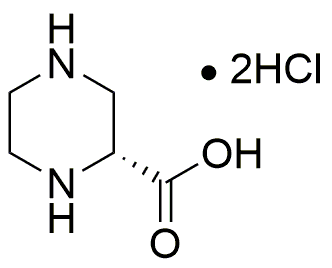(R)-2-Piperazinecarboxylic acid dihydrochloride is widely utilized in research focused on:
- Pharmaceutical Development: This compound serves as a key intermediate in the synthesis of various pharmaceuticals, particularly those targeting neurological disorders. Its unique structure allows for enhanced receptor binding, improving efficacy.
- Biochemical Research: Researchers use it in studies involving piperazine derivatives, which are important in understanding drug interactions and metabolic pathways. This can lead to the development of more effective therapeutic agents.
- Analytical Chemistry: It is employed as a standard in chromatographic techniques, helping to ensure accurate quantification of related compounds in complex mixtures, which is crucial for quality control in drug manufacturing.
- Material Science: The compound is explored for its potential in creating novel polymers and materials with specific properties, such as improved strength or flexibility, which can be beneficial in various industrial applications.
- Agrochemical Formulations: Its role in the formulation of agrochemicals helps enhance the delivery and effectiveness of active ingredients, contributing to more efficient agricultural practices.
General Information
Properties
Safety and Regulations
Applications
(R)-2-Piperazinecarboxylic acid dihydrochloride is widely utilized in research focused on:
- Pharmaceutical Development: This compound serves as a key intermediate in the synthesis of various pharmaceuticals, particularly those targeting neurological disorders. Its unique structure allows for enhanced receptor binding, improving efficacy.
- Biochemical Research: Researchers use it in studies involving piperazine derivatives, which are important in understanding drug interactions and metabolic pathways. This can lead to the development of more effective therapeutic agents.
- Analytical Chemistry: It is employed as a standard in chromatographic techniques, helping to ensure accurate quantification of related compounds in complex mixtures, which is crucial for quality control in drug manufacturing.
- Material Science: The compound is explored for its potential in creating novel polymers and materials with specific properties, such as improved strength or flexibility, which can be beneficial in various industrial applications.
- Agrochemical Formulations: Its role in the formulation of agrochemicals helps enhance the delivery and effectiveness of active ingredients, contributing to more efficient agricultural practices.
Documents
Safety Data Sheets (SDS)
The SDS provides comprehensive safety information on handling, storage, and disposal of the product.
Product Specification (PS)
The PS provides a comprehensive breakdown of the product’s properties, including chemical composition, physical state, purity, and storage requirements. It also details acceptable quality ranges and the product's intended applications.
Certificates of Analysis (COA)
Search for Certificates of Analysis (COA) by entering the products Lot Number. Lot and Batch Numbers can be found on a product’s label following the words ‘Lot’ or ‘Batch’.
*Catalog Number
*Lot Number
Certificates Of Origin (COO)
This COO confirms the country where the product was manufactured, and also details the materials and components used in it and whether it is derived from natural, synthetic, or other specific sources. This certificate may be required for customs, trade, and regulatory compliance.
*Catalog Number
*Lot Number
Safety Data Sheets (SDS)
The SDS provides comprehensive safety information on handling, storage, and disposal of the product.
DownloadProduct Specification (PS)
The PS provides a comprehensive breakdown of the product’s properties, including chemical composition, physical state, purity, and storage requirements. It also details acceptable quality ranges and the product's intended applications.
DownloadCertificates of Analysis (COA)
Search for Certificates of Analysis (COA) by entering the products Lot Number. Lot and Batch Numbers can be found on a product’s label following the words ‘Lot’ or ‘Batch’.
*Catalog Number
*Lot Number
Certificates Of Origin (COO)
This COO confirms the country where the product was manufactured, and also details the materials and components used in it and whether it is derived from natural, synthetic, or other specific sources. This certificate may be required for customs, trade, and regulatory compliance.


